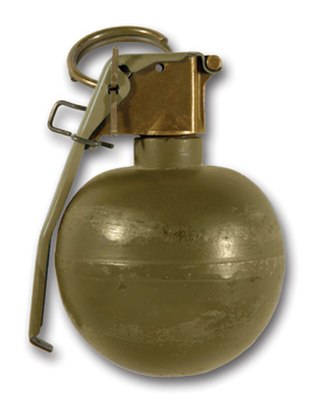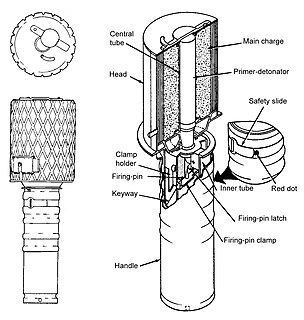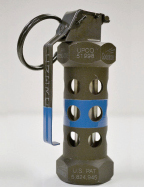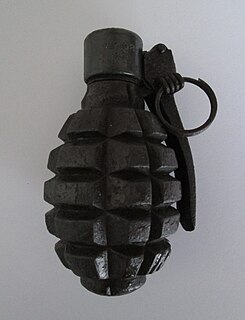
A bomb is an explosive weapon that uses the exothermic reaction of an explosive material to provide an extremely sudden and violent release of energy. Detonations inflict damage principally through ground- and atmosphere-transmitted mechanical stress, the impact and penetration of pressure-driven projectiles, pressure damage, and explosion-generated effects. Bombs have been utilized since the 11th century starting in East Asia.

A pipe bomb is an improvised explosive device, which uses a tightly sealed section of pipe filled with an explosive material. The containment provided by the pipe means that simple low explosives can be used to produce a relatively large explosion due to the containment causing increased pressure, and the fragmentation of the pipe itself creates potentially lethal shrapnel.

The Stielhandgranate was a German hand grenade of unique design. It was the standard issue of the German Empire during World War I, and became the widespread issue of Nazi Germany's Wehrmacht during World War II. The very distinctive appearance led to it being called a "stick grenade", or "potato masher" in British Army slang, and is today one of the most easily recognized infantry weapons of the 20th century.

The grenade, hand No. 1 was the first British hand grenade used in World War I. It was designed in the Royal Laboratory, based on reports and samples of Japanese hand grenades during the Russo-Japanese War provided by General Sir Aylmer Haldane, who was a British observer of that war.

The double cylinder, Nos. 8 and No. 9 hand grenades, also known as the "jam tins", are a type of improvised explosive device used by the British and Commonwealth forces, notably the Australian and New Zealand armies in World War I. The jam tin, or bully beef tin, was one of many grenades designed by ANZACs in the early part of the First World War in response to a lack of equipment suited to trench warfare.

The M67 grenade is a fragmentation hand grenade used by the United States military. The M67 is a further development of the M33 grenade, itself a replacement for the M26-series grenades used during the Korean and Vietnam Wars, and the older Mk 2 "pineapple" grenade used since World War I.

The Mk 2 grenade is a fragmentation type anti-personnel hand grenade introduced by the U.S. armed forces in 1918. It was the standard issue anti-personnel grenade used during World War II and in later conflicts, including the Vietnam War. Replacing the failed Mk 1 grenade of 1917, it was standardized in 1920 as the Mk II, and redesignated the Mk 2 on April 2, 1945.

The Soviet RGD-33 is an anti-personnel fragmentation stick grenade developed in 1933.
The military of the United States has used many of different types of hand grenades since its foundation. Presented on this page is a basic overview.

The Model 39 "Eihandgranate",M39 or Eierhandgranate 39 was a German fragmentation hand grenade introduced in 1939 and produced until the end of World War II.

The M84 also known as a flashbang or stun grenade, is the currently-issued stun grenade of the United States Military and SWAT teams throughout the United States. Upon detonation, it emits an intensely loud "bang" of 170–180 decibels and a blinding flash of more than one million candela within five feet of initiation, sufficient to cause immediate flash blindness, deafness, tinnitus, and inner ear disturbance. Exposed personnel experience disorientation, confusion and loss of coordination and balance. While these effects are all intended to be temporary, there is risk of permanent injury. Consequently, the M84 is classified as a less-lethal weapon.

The granat obronny wz. 33 was a fragmentation grenade used by the Polish Army before and during World War II. The shell casing was molded from cast iron and formed into a pineapple-shaped oval, typical of World War I and II-era hand grenades.
The Kugelhandgranate is the name given to a model of a hand thrown fragmentation grenade manufactured in Germany also known as Mod. 1913.
In military munitions, a fuze is the part of the device that initiates function. In some applications, such as torpedoes, a fuze may be identified by function as the exploder. The relative complexity of even the earliest fuze designs can be seen in cutaway diagrams.

A grenade is an explosive weapon typically thrown by hand, but can also refer to projectiles shot out of grenade launchers. Generally, a grenade consists of an explosive charge, a detonating mechanism, and firing pin inside the grenade to trigger the detonating mechanism. Once the soldier throws the grenade, the safety lever releases, the striker throws the safety lever away from the grenade body as it rotates to detonate the primer. The primer explodes and ignites the fuze. The fuze burns down to the detonator, which explodes the main charge.
The No. 15 ball grenade was a grenade used by the British during World War I.

The SRCM Mod. 35 is a hand grenade that was first issued to the Royal Italian Army in 1935, serving through World War II and into the 1980s. Nicknamed "Red Devils" by the British in 1941-1942 during the North African Campaign after the red color of the most common type.

The Shaving Stick Grenade was an offensive grenade that was developed by Germany and used by the Wehrmacht during World War II.













